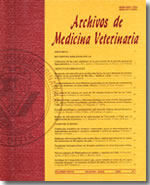Effect of the infection with Eimeria acervulina, E. maxima and E. tenella on pigment absorption and skin deposition in broiler chickens
Main Article Content
Abstract
Two experiments were conducted in broiler chickens from 21 to 49 d of age to evaluate the plasmatic level, deposition, and digestibility of xanthophylls (XA) from marigold flower (Tagetes erecta) after infection with vaccine strains of Eimeria spp. In Experiment 1, 432 birds were assigned to 4 treatments: 1) non-infected control; 2) 8.32 x 104 sporulated Eimeria oocysts (SEO)/bird; 3) 17.82 x 104 SEO/bird, and 4) 49.92 x 104 SEO/bird. In Experiment 2, 400 broilers were assigned to 4 treatments: 1) non-infected control; treatments 2 to 4 were challenged with 8.32 x 104 SEO/bird. The birds received 85, 108, 141, and 162ppm of total dietary XA from d 35 to 49 for treatments 1 to 4, respectively. Both experiments contained 4 replications (2/sex) per treatment. In Experiment 1, the SEO dose was associated with the reduction in body weight gain (BWG), skin yellowness units (b*), and plasma xanthophylls (PX). In both sexes, b* increased by 1.36/d of XA consumption. For every 104 SEO, PX decreased by 0.8 μg/ml/d, and 0.06b*. In Experiment 2, no difference was detected in PX or b* at 49 d between treatments. XA digestibility decreased by 15 units in the infected birds. Results suggest that XA digestion and absorption are similar between males and females. However, females have a greater ability for skin XA deposition. After a mild Eimeria spp. infection, it is possible to achieve adequate skin yellowness (SY) levels if the infected birds are treated immediately and receive at least 62 mg of dietary XA/bird for 14 d.

